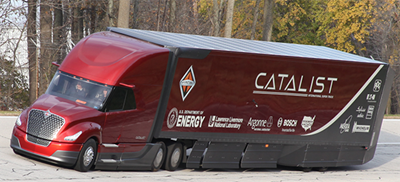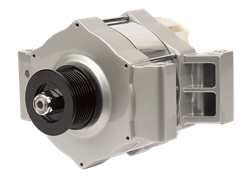
Achieve 50 percent improvement over benchmark—that was the Department of Energy’s (DOE) challenge, in the form of the SuperTruck Initiative. Navistar decided to meet the challenge and asked us to join the effort. The result is an innovation that’s sure to influence future products.
After 2½ years of dedicated effort, Navistar’s SuperTruck demonstration vehicle, CatalIST, achieved fuel efficiency of 13 miles per gallon and demonstrated 50.3 percent Brake Thermal Efficiency (BTE) and a path towards 55 percent BTE. This was a freight efficiency improvement of 104 percent—more than double the 50 percent goal set by the DOE for its SuperTruck program.
Why We Accepted the Challenge
“We are, first and foremost, systems integrators,” says Randy Jarvis, Navistar Global Account Manager for BorgWarner. “Our goal is product leadership that exceeds customers’ expectations, so this challenge was right in our sweet spot. But that doesn’t mean it was easy. We knew we needed some seriously advanced electrification technology to help Navistar improve its overall efficiency.”
The SuperTruck team, which included Jarvis and Rod Spangler, Prototype/Test Execution Manager, decided to use the 48-volt motor generator unit (MGU) for the electrification power of the vehicle.

“Our 48-volt MGU has the durability and high-density electric output we’d need for the SuperTruck vehicle architecture,” says Spangler. “They can start a vehicle, apply torque to the powertrain, recover lost energy, and manage the onboard power demand created by today’s creature comforts.”
Tackling the Challenge
The team started by configuring the N13 Navistar engine with the MGU on an engine stand. Test results were positive, so they moved it to the truck. They worked on the space claim with new bracketing and installed new cabling. They also installed a water-cooling system.
Next, our engineers worked to meet the challenge of supplying electric power to systems with different voltage requirements.

“48-volt motor generators are clearly the way to go with many commercial vehicles, including Class 8 trucks,” says Spangler. “They have the power you need, and can serve several different kinds of vehicle platform designs. But manufacturers won’t be changing the specifications of onboard electric systems to 48-volt in the near future.”
He says they designed a stepdown transformer that uses 48-volts for the charging system, 24-volts to start the vehicle, and 12-volts to power all the instrument clusters, lights and onboard electrics.
“It’s a solution that measurably increases fuel efficiency, but doesn’t require a complete redesign of every other electric system,” Spangler says.
The team’s efforts resulted in a true SuperTruck. The increase in freight efficiency—a combination of fuel used and freight hauled—was 104 percent. The Delco Remy 39MT™ stop/start starter motor in the SuperTruck played an important part in achieving such high fuel efficiency. By turning the vehicle off when stopped, and then starting it when the gas is pressed, the 39MT stop/start feature prevents fuel burn when the truck is idle, essentially conserving fuel and saving fleets money.
Innovation for the Future
The SuperTruck Initiative is an important step in fuel conservation and environmental responsibility. Long haul trucks rule in freight transportation, delivering 80 percent of the goods we use. And while they only make up 4 percent of the vehicles on the road, they consume about 20 percent of the fuel.
The results of the SuperTruck Initiative have demonstrated that significant improvements can be made to today’s vehicles with existing components, and that advanced technology and creative engineering collaborations can make a profound difference in fuel efficiency.